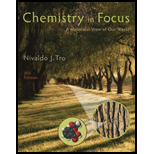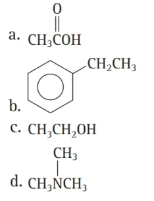
Chemistry In Focus
6th Edition
ISBN: 9781305084476
Author: Tro, Nivaldo J., Neu, Don.
Publisher: Cengage Learning
expand_more
expand_more
format_list_bulleted
Concept explainers
Textbook Question
Chapter 6, Problem 59E
Identify each compound according to its

Expert Solution & Answer
Trending nowThis is a popular solution!

Students have asked these similar questions
Predict the major products of this reaction:
excess
H+
NaOH
?
A
Note that the first reactant is used in excess, that is, there is much more of the first reactant than the second.
If there won't be any products, just check the box under the drawing area instead.
Explanation
Check
Click and drag to start drawing a
structure.
© 2025 McGraw Hill LLC. All Rights Reserved. Terms of Use Priv
1. For each of the reaction "railroads" below, you are either asked to give the structure(s) of the starting
material(s) or product(s), or provide reagents/conditions to accomplish the transformation, as
indicated by the boxes.
a.
NaOMe
H+
.CO,H
HO₂C
MeOH (excess)
MeOH
H3C
Br
يع
CH3
1. LiAlH4
2. H3O+
3. PBг3
H3C
1. Et-Li
2. H3O+
-CO₂Me
-CO₂Me
OH
CH3
CH3
ল
CH3
Predict the intermediate 1 and final product 2 of this organic reaction:
NaOMe
ག1, ད།་, -
+
H
You can draw 1 and 2 in any arrangement you like.
2
work up
Note: if either 1 or 2 consists of a pair of enantiomers, just draw one structure using line bonds instead of 3D (dash and wedge)
bonds at the chiral center.
Explanation
Check
Click and drag to start drawing a structure.
Х
© 2025 McGraw Hill LLC. All Rights Reserved. Terms of Use | P
Chapter 6 Solutions
Chemistry In Focus
Ch. 6 - Drawing Structural and Condensed Structural...Ch. 6 - Prob. 6.2YTCh. 6 - Drawing Structural Formulas for Isomers Draw...Ch. 6 - Prob. 6.4YTCh. 6 - What are the names of the straight-chain alkanes...Ch. 6 - Which structure corresponds to CH2=CHCH3?Ch. 6 - For the following molecule, why is the name...Ch. 6 - What property is characteristic of chlorinated...Ch. 6 - Prob. 5SCCh. 6 - Prob. 6SC
Ch. 6 - Prob. 7SCCh. 6 - Prob. 1ECh. 6 - Prob. 2ECh. 6 - Prob. 3ECh. 6 - Prob. 4ECh. 6 - What is vitalism? Why did vitalism become a...Ch. 6 - Prob. 6ECh. 6 - Prob. 7ECh. 6 - Prob. 8ECh. 6 - Prob. 9ECh. 6 - List four common fuels used by our society, and...Ch. 6 - Prob. 11ECh. 6 - Why are alkenes and alkynes called unsaturated...Ch. 6 - Prob. 13ECh. 6 - Prob. 14ECh. 6 - Prob. 15ECh. 6 - Prob. 16ECh. 6 - Prob. 17ECh. 6 - Prob. 18ECh. 6 - Prob. 19ECh. 6 - Prob. 20ECh. 6 - Prob. 21ECh. 6 - Prob. 22ECh. 6 - Prob. 23ECh. 6 - Prob. 24ECh. 6 - Prob. 25ECh. 6 - Prob. 26ECh. 6 - Prob. 27ECh. 6 - Prob. 28ECh. 6 - Prob. 29ECh. 6 - Prob. 30ECh. 6 - Prob. 31ECh. 6 - Prob. 32ECh. 6 - Prob. 33ECh. 6 - Prob. 34ECh. 6 - Prob. 35ECh. 6 - Prob. 36ECh. 6 - Prob. 37ECh. 6 - Prob. 38ECh. 6 - Prob. 39ECh. 6 - Prob. 40ECh. 6 - Prob. 41ECh. 6 - Prob. 42ECh. 6 - Naming Hydrocarbons Name each alkane:Ch. 6 - Name each alkane:Ch. 6 - Name each alkyne:Ch. 6 - Name each alkyne: a.CH3CHCHCH2CH2CH3Ch. 6 - Name each alkyne:Ch. 6 - Prob. 48ECh. 6 - Prob. 49ECh. 6 - Prob. 50ECh. 6 - Drawing Hydrocarbon Structures from Names Draw the...Ch. 6 - Draw the condensed structural formula for each...Ch. 6 - Prob. 53ECh. 6 - Prob. 54ECh. 6 - Prob. 55ECh. 6 - Prob. 56ECh. 6 - Functionalized Hydrocarbons Identify each compound...Ch. 6 - Identify each compound according to its functional...Ch. 6 - Identify each compound according to its functional...Ch. 6 - Identify each compound according to its functional...Ch. 6 - Propane, CH3CH2CH3, is a gas at room temperature,...Ch. 6 - Prob. 62ECh. 6 - What was the impact of vitalisms downfall on...Ch. 6 - Why do you think our society has mixed feelings...Ch. 6 - Prob. 65ECh. 6 - Prob. 66ECh. 6 - Prob. 67ECh. 6 - Any one molecule can be represented many ways. For...Ch. 6 - Explain why the formula CH3CH2CH3 cannot mean:...Ch. 6 - Prob. 70ECh. 6 - Prob. 71ECh. 6 - Prob. 72ECh. 6 - Prob. 73E
Knowledge Booster
Learn more about
Need a deep-dive on the concept behind this application? Look no further. Learn more about this topic, chemistry and related others by exploring similar questions and additional content below.Similar questions
- What is the total energy cost associated with the compound below adopting the shown conformation? CH3 HH DH CH3arrow_forwardΗΝ, Draw Final Product C cyclohexanone pH 4-5 Edit Enamine H3O+ CH3CH2Br THF, reflux H Edit Iminium Ionarrow_forwardHow many hydrogen atoms are connected to the indicated carbon atom?arrow_forward
- Identify the compound with the longest carbon - nitrogen bond. O CH3CH2CH=NH O CH3CH2NH2 CH3CH2C=N CH3CH=NCH 3 The length of all the carbon-nitrogen bonds are the samearrow_forwardIdentify any polar covalent bonds in epichlorohydrin with S+ and 8- symbols in the appropriate locations. Choose the correct answer below. Η H's+ 6Η Η Η Η Η Ηδ Η Ο Ο HH +Η Η +Η Η Η -8+ CIarrow_forwardH H:O::::H H H HH H::O:D:D:H HH HH H:O:D:D:H .. HH H:O:D:D:H H H Select the correct Lewis dot structure for the following compound: CH3CH2OHarrow_forward
- Rank the following compounds in order of decreasing boiling point. ннннн -С-С-Н . н-с- ННННН H ΗΤΗ НННН TTTĪ н-с-с-с-с-о-н НННН НН C' Н н-с-с-с-с-н НН || Ш НННН H-C-C-C-C-N-H ННННН IVarrow_forwardRank the following compounds in order of decreasing dipole moment. |>||>||| ||>|||>| |>|||>|| |||>||>| O ||>>||| H F H F H c=c || H c=c F F IIIarrow_forwardchoose the description that best describes the geometry for the following charged species ch3-arrow_forward
- Why isn't the ketone in this compound converted to an acetal or hemiacetal by the alcohol and acid?arrow_forwardWhat is the approximate bond angle around the nitrogen atom? HNH H Harrow_forwardOH 1. NaOCH2CH3 Q 2. CH3CH2Br (1 equiv) H3O+ Select to Draw 1. NaOCH2 CH3 2. CH3Br (1 equiv) heat Select to Edit Select to Drawarrow_forward
arrow_back_ios
SEE MORE QUESTIONS
arrow_forward_ios
Recommended textbooks for you
- Chemistry: Matter and ChangeChemistryISBN:9780078746376Author:Dinah Zike, Laurel Dingrando, Nicholas Hainen, Cheryl WistromPublisher:Glencoe/McGraw-Hill School Pub Co

 Organic ChemistryChemistryISBN:9781305580350Author:William H. Brown, Brent L. Iverson, Eric Anslyn, Christopher S. FootePublisher:Cengage Learning
Organic ChemistryChemistryISBN:9781305580350Author:William H. Brown, Brent L. Iverson, Eric Anslyn, Christopher S. FootePublisher:Cengage Learning  World of Chemistry, 3rd editionChemistryISBN:9781133109655Author:Steven S. Zumdahl, Susan L. Zumdahl, Donald J. DeCostePublisher:Brooks / Cole / Cengage Learning
World of Chemistry, 3rd editionChemistryISBN:9781133109655Author:Steven S. Zumdahl, Susan L. Zumdahl, Donald J. DeCostePublisher:Brooks / Cole / Cengage Learning Introductory Chemistry: A FoundationChemistryISBN:9781337399425Author:Steven S. Zumdahl, Donald J. DeCostePublisher:Cengage Learning
Introductory Chemistry: A FoundationChemistryISBN:9781337399425Author:Steven S. Zumdahl, Donald J. DeCostePublisher:Cengage Learning Chemistry & Chemical ReactivityChemistryISBN:9781337399074Author:John C. Kotz, Paul M. Treichel, John Townsend, David TreichelPublisher:Cengage Learning
Chemistry & Chemical ReactivityChemistryISBN:9781337399074Author:John C. Kotz, Paul M. Treichel, John Townsend, David TreichelPublisher:Cengage Learning

Chemistry: Matter and Change
Chemistry
ISBN:9780078746376
Author:Dinah Zike, Laurel Dingrando, Nicholas Hainen, Cheryl Wistrom
Publisher:Glencoe/McGraw-Hill School Pub Co


Organic Chemistry
Chemistry
ISBN:9781305580350
Author:William H. Brown, Brent L. Iverson, Eric Anslyn, Christopher S. Foote
Publisher:Cengage Learning

World of Chemistry, 3rd edition
Chemistry
ISBN:9781133109655
Author:Steven S. Zumdahl, Susan L. Zumdahl, Donald J. DeCoste
Publisher:Brooks / Cole / Cengage Learning

Introductory Chemistry: A Foundation
Chemistry
ISBN:9781337399425
Author:Steven S. Zumdahl, Donald J. DeCoste
Publisher:Cengage Learning

Chemistry & Chemical Reactivity
Chemistry
ISBN:9781337399074
Author:John C. Kotz, Paul M. Treichel, John Townsend, David Treichel
Publisher:Cengage Learning
Alcohols, Ethers, and Epoxides: Crash Course Organic Chemistry #24; Author: Crash Course;https://www.youtube.com/watch?v=j04zMFwDeDU;License: Standard YouTube License, CC-BY